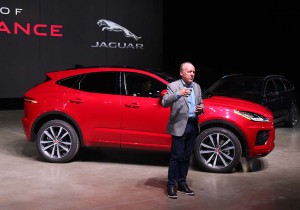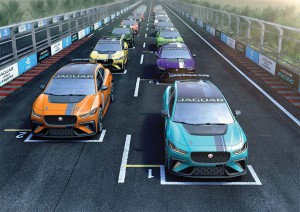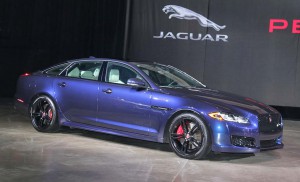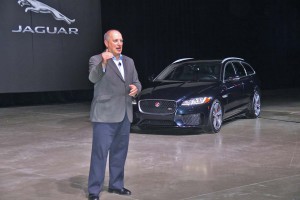Say the name, Jaguar, and you’re likely to picture a sleek sports car like the F-Type or a sexy sports sedan, like the big XJ. But reality for the British automaker is starting to look quite different.
Sure, it’s getting ready to roll out the $187,500 XE SV Project 8, at 592 horsepower the most powerful street-legal model it has ever produced. But when it comes to moving the sales needle, you need to look in the other direction, starting with the F-Pace, the British maker’s first sport-utility vehicle. After a long, downward spiral it almost single-handedly transformed Jaguar into the world’s fastest-growing automotive brand in 2016.
Now, Jaguar is hoping to pull off a similar feat with the launch of its second utility vehicle, the smaller E-Pace, which it rolled out for a sedate U.S. debut on Thursday after a much more spectacular unveiling in London two months ago. A third ute, the I-Pace, will feature a pure battery-electric drivetrain, will come to market late next year.
For a carmaker that dithered for decades before introducing its first station wagon, “Who’d have thought, five years ago, that we’d now have three SUVs in Jaguar,” laughed the brand’s global design chief Ian Callum, during the Detroit preview.
The I-Pace will anchor another move likely to shock Jaguar traditionalists, Joe Eberhardt, CEO of Jaguar Land Rover North America noting that “by 2020, all new Jaguar Land Rover vehicles launched will be offered with an electric or electrified powertrain option.”
For the moment, the I-Pace is the only all-electric model in the works for either Jaguar or its Land Rover sibling, but “you can assume” that the underlying platform, unique to that battery-SUV, was designed to be used for other models, a senior JLR official told TheDetroitBureau.com.
And if – make that when – the next model comes out it also will be a utility vehicle, the underlying, skateboard-like platform not designed for use in a sedan, coupe or sports car. Of course, that doesn’t rule out the possibility that Jaguar could come up with an additional platform for an all-electric passenger car at some future point.
(Jaguar goes loopy at UK launch of new E-Pace SUV. Click Here to see why the debut set a new Guinness World Record.)
Under the new strategy, expect to see a mix of conventional hybrids, plug-ins and pure battery-electric vehicles. Based on the weak demand for an early hybrid from Land Rover, the British-based, Indian-owner JLR is betting that the bulk of its orders will come in for the plug-in hybrid drivertrains it is now working on.
Specific details haven’t been released, but officials stressed that both Jaguar and Land Rover will put the emphasis on performance, rather than seeking to deliver the absolute maximum in range and fuel efficiency – a strategy that reflects the direction other high-line makers, from Audi to Porsche to Tesla, are taking.
To help get the message across, Jaguar will launch the new e-Trophy, a race series featuring modified versions of the I-Pace that will serve as a support event for the increasingly popular Formula E program.
While JLR will join a growing list of manufacturers – including such high-line competitors as Aston Martin, Audi, BMW, Mercedes-Benz and Volvo – charging into the electrified market, “We still love our bubbly V-8s,” stressed Callum.
And nothing proves that better than the Project 8, which will hit 60 in 3.3 seconds and top out at just over 200 mph. Developed by the carmaker’s Special Vehicle Operations, or SVO, team, only 300 of the supercharged 5.0-liter V-8 sedans will be produced.
(For more on the Jaguar XE SV Project 8, Click Here.)
But while such high-performance passenger cars might draw the headlines and stares, Jaguar’s reality is clearly turning in a different direction. Globally, combined JLR sales surged 24%, to 583,000 vehicles in 2016, with North American demand rising 24 percent. SUVs dominated that tally, accounting for all of Land Rover’s total and a fast-growing share of Jaguar’s.
The F-Pace—which was named World Car of the Year in April — is already that brand’s top-seller, and with the launch of the E-Pace, utes will overwhelmingly dominate the Jaguar mix going forward.
(Jaguar F-Pace named World Car of the Year. Click Here to learn why.)





I’m sure the shooters at Ford will never understand how they mismanaged Jag vs. the approach Tata is taking. I’m sure not even a Tata fastener is used on a Jag much less a platform.